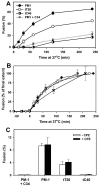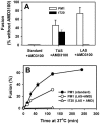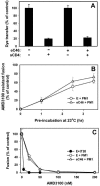Membrane-anchored inhibitory peptides capture human immunodeficiency virus type 1 gp41 conformations that engage the target membrane prior to fusion
- PMID: 16537592
- PMCID: PMC1440409
- DOI: 10.1128/JVI.80.7.3249-3258.2006
Membrane-anchored inhibitory peptides capture human immunodeficiency virus type 1 gp41 conformations that engage the target membrane prior to fusion
Abstract
Soluble peptides derived from the C-terminal heptad repeat domain of human immunodeficiency virus type 1 (HIV-1) gp41 are potent inhibitors of HIV-1 entry and gp41-induced fusion. Target membrane-anchored variants of these peptides have been shown to retain inhibitory activity. Both soluble and membrane-anchored C peptides (MACs) are thought to block fusion by binding to the N-terminal coiled coil domain of gp41 and preventing formation of the final six-helix bundle structure. However, interactions of target MACs with gp41 must be restricted to a subset of trimers that have their hydrophobic fusion peptides inserted into the target membrane. This unique feature of MACs was used to identify the intermediate step of fusion at which gp41 engaged the target membrane. Fusion between HIV envelope-expressing effector cells and target cells was measured by fluorescence microscopy. Expression of MACs in target cells led to less than twofold reduction in the extent of fusion. However, when reaction was first arrested by adding lysolipids that disfavored membrane merger, and the lipids were subsequently removed by washing, control cells supported fusion, whereas those that expressed MACs did not. The drastically improved potency of MACs implies that, at lipid-arrested stage, gp41 bridges the viral and target cell membranes and therefore more optimally binds the membrane-anchored peptides. Experimental demonstration of this intermediate shows that, similar to fusion induced by many other viral glycoproteins, engaging the target membrane by HIV-1 gp41 permits coupling between six-helix bundle formation and membrane merger.
Figures






Similar articles
-
The cytoplasmic tail slows the folding of human immunodeficiency virus type 1 Env from a late prebundle configuration into the six-helix bundle.J Virol. 2005 Jan;79(1):106-15. doi: 10.1128/JVI.79.1.106-115.2005. J Virol. 2005. PMID: 15596806 Free PMC article.
-
N-substituted pyrrole derivatives as novel human immunodeficiency virus type 1 entry inhibitors that interfere with the gp41 six-helix bundle formation and block virus fusion.Antimicrob Agents Chemother. 2004 Nov;48(11):4349-59. doi: 10.1128/AAC.48.11.4349-4359.2004. Antimicrob Agents Chemother. 2004. PMID: 15504864 Free PMC article.
-
HIV-1 gp41: mediator of fusion and target for inhibition.AIDS Rev. 2003 Oct-Dec;5(4):214-21. AIDS Rev. 2003. PMID: 15012000 Review.
-
ADS-J1 inhibits HIV-1 infection and membrane fusion by targeting the highly conserved pocket in the gp41 NHR-trimer.Biochim Biophys Acta. 2014 May;1838(5):1296-305. doi: 10.1016/j.bbamem.2013.12.022. Epub 2014 Jan 3. Biochim Biophys Acta. 2014. PMID: 24388952
-
Biochemistry and biophysics of HIV-1 gp41 - membrane interactions and implications for HIV-1 envelope protein mediated viral-cell fusion and fusion inhibitor design.Curr Top Med Chem. 2011 Dec;11(24):2959-84. doi: 10.2174/156802611798808497. Curr Top Med Chem. 2011. PMID: 22044229 Free PMC article. Review.
Cited by
-
A monoclonal Fab derived from a human nonimmune phage library reveals a new epitope on gp41 and neutralizes diverse human immunodeficiency virus type 1 strains.J Virol. 2007 Dec;81(23):12946-53. doi: 10.1128/JVI.01260-07. Epub 2007 Sep 26. J Virol. 2007. PMID: 17898046 Free PMC article.
-
Efficient entry inhibition of human and nonhuman primate immunodeficiency virus by cell surface-expressed gp41-derived peptides.Gene Ther. 2008 Sep;15(17):1210-22. doi: 10.1038/gt.2008.73. Epub 2008 May 1. Gene Ther. 2008. PMID: 18449216 Free PMC article.
-
Multispecific anti-HIV duoCAR-T cells display broad in vitro antiviral activity and potent in vivo elimination of HIV-infected cells in a humanized mouse model.Sci Transl Med. 2019 Aug 7;11(504):eaav5685. doi: 10.1126/scitranslmed.aav5685. Sci Transl Med. 2019. PMID: 31391322 Free PMC article.
-
Subcellular targeting strategies for drug design and delivery.Nat Rev Drug Discov. 2010 Jan;9(1):29-42. doi: 10.1038/nrd2897. Nat Rev Drug Discov. 2010. PMID: 20043027 Review.
-
Common principles and intermediates of viral protein-mediated fusion: the HIV-1 paradigm.Retrovirology. 2008 Dec 10;5:111. doi: 10.1186/1742-4690-5-111. Retrovirology. 2008. PMID: 19077194 Free PMC article. Review.
References
-
- Binley, J. M., R. W. Sanders, B. Clas, N. Schuelke, A. Master, Y. Guo, F. Kajumo, D. J. Anselma, P. J. Maddon, W. C. Olson, and J. P. Moore. 2000. A recombinant human immunodeficiency virus type 1 envelope glycoprotein complex stabilized by an intermolecular disulfide bond between the gp120 and gp41 subunits is an antigenic mimic of the trimeric virion-associated structure. J. Virol. 74:627-643. - PMC - PubMed
Publication types
MeSH terms
Substances
Grants and funding
LinkOut - more resources
Full Text Sources
Other Literature Sources
Miscellaneous

